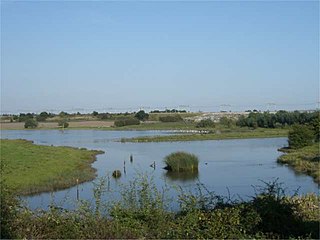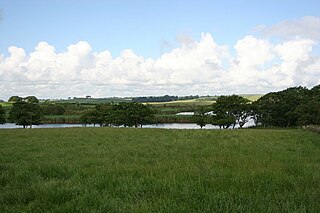
A reedbed or reed bed is a natural habitat found in floodplains, waterlogged depressions and estuaries. Reedbeds are part of a succession from young reeds colonising open water or wet ground through a gradation of increasingly dry ground. As reedbeds age, they build up a considerable litter layer that eventually rises above the water level and that ultimately provides opportunities in the form of new areas for larger terrestrial plants such as shrubs and trees to colonise.
Bolshayne Fen is a wetland in southeast Devon, England. It has an area of 1.62 hectares.

Sandbach Flashes are a group of 14 wetlands west of Sandbach in Cheshire, England. The flashes were designated as a Site of Special Scientific Interest in 1963, with a total area of 1.53 km2. There are a number of individual flashes including Bottom's Flash, Crabmill Flash, Elton Hall Flash, Fodens Flash, Groby's Flash, Ilse Pool, Moston Flashes, Pump House Flash, Railway Flash, Red Lane Tip and Pool, and Watch Lane Flash.
This article gives an overview of the swamp and tall-herb fen communities in the British National Vegetation Classification system.
Yanal Bog is a 1.6 hectare biological Site of Special Scientific Interest on the southern edge of the North Somerset Levels, just north of the village of Sandford, North Somerset. It was notified as an SSSI in 1988.

Windsor Hill Marsh is a 0.84 hectare biological Site of Special Scientific Interest, north of the town of Shepton Mallet in Somerset, and adjacent to the Windsor Hill Quarry geological Site of Special Scientific Interest. It was notified in January 1972.

Purple moor grass and rush pastures is a type of Biodiversity Action Plan habitat in the UK. It occurs on poorly drained neutral and acidic soils of the lowlands and upland fringe. It is found in the South West of England, especially in Devon.

Blo' Norton and Thelnetham Fens are a 21.3-hectare (53-acre) biological Site of Special Scientific Interest (SSSI) on the Norfolk/Suffolk border. Blo' Norton Fen is in the parish of Blo' Norton in Norfolk and Thelnetham Fen is in Thelnetham parish in Suffolk. It is a Nature Conservation Review site, Grade 2, and part of the Waveney and Little Ouse Valley Fens Special Area of Conservation, Thelnetham Fen is managed by the Suffolk Wildlife Trust and Blo' Norton Fen by the Little Ouse Headwaters Project (LOHP).
Old River Bed, Shrewsbury is a Site of Special Scientific Interest located two miles north of Shrewsbury town centre, to the east of the A528 in Shropshire, England. It is currently owned and managed by Shrewsbury Town Council.

Llyn Bodgylched is a Site of Special Scientific Interest in Anglesey, North Wales, to the west of Beaumaris. It has been designated as a Site of Special Scientific Interest since January 1968 in an attempt to protect its fragile biological elements, mainly a swamp. The site has an area of 16.37 hectares and is managed by Natural Resources Wales.
Machynys Ponds is a Site of Special Scientific Interest (SSSI) in Carmarthenshire, Wales, designated in 1993 for its botanical features.

Arcot Hall Grasslands and Ponds is the name given to a Site of Special Scientific Interest (SSSI) near Cramlington in Northumberland, England, notable as the largest lowland species-rich grassland in North East England. The site is composed of grassland, heath, ponds, and associated damp habitats now rare in Northumberland.

Bewick and Beanley Moors is the name given to a Site of Special Scientific Interest (SSSI) in north Northumberland, in the north-east of England. The moors are asserted to be of national importance by Natural England for the extent, quality and diversity of upland types including heaths, fens, wet grassland, flushes, mires and blanket bogs, together creating an extensive mosaic habitat supporting an exceptional community of amphibians. The moors are important, too, for their relict juniper woodland and scrub.

Bishop Monkton Ings is a Site of Special Scientific Interest, or SSSI, situated east of Bishop Monkton village in North Yorkshire, England. It consists mostly of marshy, calcareous grassland, with some broadleaved woodland, and some fen alongside the two watercourses which run through the site. This varied wetland forms a habitat for a variety of plants, including the semi-parasitic marsh lousewort (Pedicularis palustris).

Grīņu Nature Reserve is a nature reserve, located in Saka Parish, South Kurzeme Municipality in the Courland region of Latvia. Founded in 1936, it belongs to the European Conservation Network Natura 2000. 1,505 hectares of natural habitat are under protection. The Grīņu Reserve is subordinated to the Regional Council for Nature Conservation Courland.










